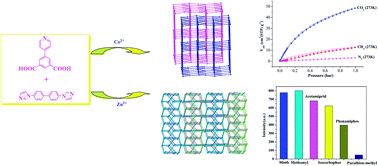A series of metal–organic frameworks based on 5-(4-pyridyl)-isophthalic acid: selective sorption and fluorescence sensing†
Abstract
Solvothermal reactions of 5-(4-pyridyl)-isophthalic acid (H2pbdc) and transition-metal centers (Ni2+/Co2+/Zn2+) in the presence (or absence) of N-auxiliary 4,4′-bis(1-imidazolyl)biphenyl (bimb) ligand produce [Ni2(pbdc)2(μ2-H2O)(H2O)2·(DMA)2.7]n (DMA = N,N′-dimethylacetamide, 1), [Ni12(pbdc)12(μ2-H2O)6(py)2(H2O)8(DMA)2·(H2O)5·(DMA)9]n (2), [Co2(pbdc)2(bimb)2·(bimb)0.5·(H2O)4·(DMF)0.25]n (3) and [Zn(pbdc)(bimb)·(H2O)]n (4), which exhibit structural diversity. Both compounds 1 and 2 display a uninodal 8-connected 3D tsi net, but feature different crystal systems and space groups from each other. Compound 3 adopts a 2-fold interpenetrating binodal (3,5)-connected 3D hms net and compound 4 features a rare 2-fold interpenetrating binodal (3,4)-connected 3D fsx architecture. In particular, activated 3 shows high-efficiency for the selective sorption of small molecules, including CO2 over N2 and CH4, H2 over N2, as well as alcohols from water. More importantly, 4 represents the first report on a MOF as a promising luminescent probe for detecting pesticides, and also the very first example for detecting both pesticides and solvent molecules simultaneously.


 Please wait while we load your content...
Please wait while we load your content...